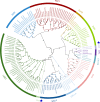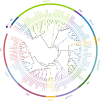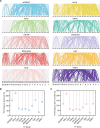Transcription factors in Orinus: novel insights into transcription regulation for speciation adaptation on the Qinghai-Xizang (Tibet) Plateau
- PMID: 40301765
- PMCID: PMC12042605
- DOI: 10.1186/s12870-025-06602-x
Transcription factors in Orinus: novel insights into transcription regulation for speciation adaptation on the Qinghai-Xizang (Tibet) Plateau
Abstract
Background: Transcription factors (TFs) are crucial regulators of plant growth, development, and resistance to environmental stresses. However, comprehensive understanding of the roles of TFs in speciation of Orinus, an extreme-habitat plant on the Qinghai-Xizang (Tibet) Plateau, is limited.
Results: Here, we identified 52 TF families, including 2125 members in Orinus, by methodically analysing domain findings, gene structures, chromosome locations, conserved motifs, and phylogenetic relationships. Phylogenetic trees were produced for each Orinus TF family using protein sequences together with wheat (Triticum aestivum L.) TFs to indicate the subgroups. The differences between Orinus and wheat species in terms of TF family size implies that both Orinus- and wheat-specific subfamily contractions (and expansions) contributed to the high adaptability of Orinus. Based on deep mining of RNA-Seq data between two species of Orinus, O. thoroldii and O. kokonoricus, we obtained differentially expressed TFs (DETFs) in 20 families, most of which were expressed higher in O. thoroldii than in O. kokonoricus. In addition, Cis-element analysis shows that MYC and G-box elements are enriched in the promoter region of DETFs, suggesting that jasmonic acid (JA) and abscisic acid (ABA) act synergistically in Orinus to enhance the signalling of related abiotic stress responses, ultimately leading to an improvement in the stress tolerance and speciation adaptation of Orinus.
Conclusions: Our data serve as a genetic resource for Orinus, not only filling the gap in studies of TF families within this genus but also providing preliminary insights into the molecular mechanisms underlying speciation in Orinus.
Keywords: Orinus; Phylogenetic relationship; Speciation adaptation; Transcription factor; Transcriptional regulation.
© 2025. The Author(s).
Conflict of interest statement
Declarations. Ethics approval and consent to participate: Not applicable. Consent for publication: All authors approved the final manuscript and the submission to this journal. Competing interests: The authors declare no competing interests.
Figures








Similar articles
-
Transcriptomic Profiles of Long Noncoding RNAs and Their Target Protein-Coding Genes Reveals Speciation Adaptation on the Qinghai-Xizang (Tibet) Plateau in Orinus.Biology (Basel). 2024 May 16;13(5):349. doi: 10.3390/biology13050349. Biology (Basel). 2024. PMID: 38785831 Free PMC article.
-
Adaptive radiation in Orinus, an endemic alpine grass of the Qinghai-Tibet Plateau, based on comparative transcriptomic analysis.J Plant Physiol. 2022 Oct;277:153786. doi: 10.1016/j.jplph.2022.153786. Epub 2022 Aug 7. J Plant Physiol. 2022. PMID: 35963042
-
A population genetics perspective on the evolutionary histories of three clonal, endemic, and dominant grass species of the Qinghai-Tibet Plateau: Orinus (Poaceae).Ecol Evol. 2019 Apr 26;9(10):6014-6037. doi: 10.1002/ece3.5186. eCollection 2019 May. Ecol Evol. 2019. PMID: 31161016 Free PMC article.
-
Transcription Factors Interact with ABA through Gene Expression and Signaling Pathways to Mitigate Drought and Salinity Stress.Biomolecules. 2021 Aug 5;11(8):1159. doi: 10.3390/biom11081159. Biomolecules. 2021. PMID: 34439825 Free PMC article. Review.
-
Transcription Factors Associated with Abiotic and Biotic Stress Tolerance and Their Potential for Crops Improvement.Genes (Basel). 2019 Sep 30;10(10):771. doi: 10.3390/genes10100771. Genes (Basel). 2019. PMID: 31575043 Free PMC article. Review.
Cited by
-
Transcriptomic Analysis Reveals the Role of Long Non-Coding RNAs in Response to Drought Stress in Tibetan Hulless Barley.Biology (Basel). 2025 Jun 20;14(7):737. doi: 10.3390/biology14070737. Biology (Basel). 2025. PMID: 40723298 Free PMC article.
References
-
- Su X, Liu T, Liu YP, Harris AJ, Chen JY. Adaptive radiation in Orinus, an endemic alpine grass of the Qinghai-Tibet plateau, based on comparative transcriptomic analysis. J Plant Physiol. 2022;277:153786. - PubMed
MeSH terms
Substances
Grants and funding
- Program No. 2023-ZJ-706/the Science and Technology Department of Qinghai Province of China
- Program No. 2023-ZJ-706/the Science and Technology Department of Qinghai Province of China
- Program No. 2023-ZJ-706/the Science and Technology Department of Qinghai Province of China
- Program No. 2023-ZJ-706/the Science and Technology Department of Qinghai Province of China
- Program No. 2023-ZJ-706/the Science and Technology Department of Qinghai Province of China
- Program No. 2023-ZJ-706/the Science and Technology Department of Qinghai Province of China
- Program No. 2023-ZJ-706/the Science and Technology Department of Qinghai Province of China
- Program No. 2023-ZJ-706/the Science and Technology Department of Qinghai Province of China
- Program No. 2023-ZJ-706/the Science and Technology Department of Qinghai Province of China
- Grant No. 32360305/National Natural Science Foundation of China
- Grant No. 32360305/National Natural Science Foundation of China
- Grant No. 32360305/National Natural Science Foundation of China
- Grant No. 32360305/National Natural Science Foundation of China
- Grant No. 32360305/National Natural Science Foundation of China
- Grant No. 32360305/National Natural Science Foundation of China
- Grant No. 32360305/National Natural Science Foundation of China
- Grant No. 32360305/National Natural Science Foundation of China
- Grant No. 32360305/National Natural Science Foundation of China
LinkOut - more resources
Full Text Sources
Miscellaneous

